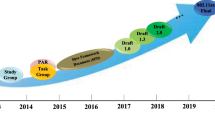Abstract
Wi-Fi has become a successful technology since the publication of its first WLAN standard due to continuous advances and updates while remaining always backwards compatible. Backwards compatibility among subsequent standards is an important feature in order to take advantage of previous equipment when publishing a new amendment. At present, IEEE 802.11b support is still mandatory to obtain the Wi-Fi certification. However, there are several harmful effects of allowing old legacy IEEE 802.11b transmissions in modern WLAN deployments. Lower throughput per device is obtained at slow rates, but also the effect known as performance anomaly, which nearly leads to starvation of fast stations, has to be taken into account. Finally, backwards compatibility mechanisms pose an important penalty in throughput performance for newer specifications. This paper presents a thorough analysis of the current state of IEEE 802.11, comparing coverage range and throughput performance among subsequent amendments, and focusing on the drawbacks and benefits of including protection mechanisms.










Similar content being viewed by others
Notes
In all cases, we assume 20 dBm of transmitted power and isotropic antennas.
Negative values for penalty in the figure mean an improvement with respect to original IEEE 802.11g performance.
L-SIG TXOP is used instead of HT Mixed mode when frame aggregation is being employed.
RTS and CTS frames are transmitted at 6 Mbps, i.e. IEEE 802.11g and IEEE 802.11a minimum basic rate.
RTS and CTS frames are transmitted at IEEE 802.11b minimum basic rate of 1 Mbps.
Again, the negative values for penalty in the figures reveal the improvement with respect to original IEEE 802.11n.
~12,000 APs were detected in different measurement campaigns in urban, commercial and residential areas in both the 2.4 and 5 GHz bands throughout the city of Barcelona and surrounding areas at different hours. A laptop equipped with an IEEE 802.11n USB dual-band (Alfa Network UBDo-a) card and an external omnidirectional antenna (Air Live WAE-5AG) were employed in order to capture management frames (Beacon, Probe Request and Response). A later analysis of the captured frames led to the results exposed.
References
IEEE. (2012). IEEE Std 802.11–2012. Wireless LAN Medium Access Control (MAC) and Physical Layer (PHY) Specifications. Revision of IEEE Std 802.11-2007.
Aruba Networks (2012). 802.11ac In-Depth. http://www.arubanetworks.com/pdf/technology/whitepapers/WP_80211acInDepth.pdf
Analyst finds 802.11ac Wi-Fi access point penetration nearly doubling every quarter. http://www.cablinginstall.com/articles/2014/09/infonetics-ac-ap-doubling.html
Heusse, M., Rousseau, F., Berger-Sabbatel, G., & Duda, A. (2003). Performance anomaly of 802.11b. In Proceedings of IEEE INFOCOM 2003.
Vucinic, M., Tourancheau, B., & Duda, A. (2012). Simulation of a backward compatible IEEE 802.11g network: Access delay and throughput performance degradation. In Proceedings of IEEE MECO 2012.
Mahasukhon, P., Hempel, M., Song, C., Sharif, H. (2007). Comparison of throughput performance for the IEEE 802.11a and 802.11g Networks. In Proceedings of IEEE AINA 2007.
Selvam, T., & Srikanth, S. (2009). Performance study of IEEE 802.11n WLANs. In Proceedings of IEEE COMSNETS 2009.
Fabris Hoefel, R. P., & Michielin Camara, A. (2011). Interoperability between IEEE 802.11n and IEEE 802.11a/g devices: Analytical and simulation results. In Proceedings of IEEE CCECE 2011.
Ong, E. H., Kneckt, J., Alanen, O., Chang, Z., Huovinen, T., & Nihtila, T. (2011). IEEE 802.11ac: Enhancements for very high throughput WLANs. In Proceedings of IEEE PIMRC 2011.
Dianu, M.-D., Riihijarvi, J., & Petrova, M. (2014). Measurement-based study of the performance of IEEE 802.11ac in an indoor environment. In Proceedings of IEEE ICC 2014.
Bejarano, O., Knightly, E. W., & Minyoung, P. (2013). IEEE 802.11ac: From channelization to multi-user MIMO. IEEE Communications Magazine, 51(10), 84–90.
Theeksha, A. P., & Srikanth, S. (2013). Performance analysis and mode selection of IEEE SU-MIMO and MU-MIMO in 802.11ac. In Proceedings of ICRTIT 2013.
Zeng, Y., Pathak, P. H., & Mohapatra, P. (2014). A first look at 802.11ac in action: Energy efficiency and interference characterization. In Proceedings of IEEE IFIP networking conference 2014.
Han, S., Zhang, X., & Shin, K. (20165). Fair and efficient coexistence of heterogeneous channel widths in next-generation wireless LANs. IEEE Transactions on Mobile Computing.
IEEE P802.11 (2004). TGn Channel Models. doc.: IEEE 802.11-03/940r4.
IEEE P802.11 (2015). TGah Channel Models. doc.: IEEE 802.11-11/0968r4.
AirMagnet 802.11a/b/g/n Wireless PC Card (C1060) Datasheet, 2010. http://airmagnet.flukenetworks.com/assets/AirMagnet_802.11abgn_WirelessPCcard_TechSpec.pdf
Cisco Aironet 1830 Series Access Points, 2016. http://www.cisco.com/c/en/us/products/collateral/wireless/aironet-1830-series-access-points/datasheet-c78-735582.pdf
Plets, D., Joseph, W., Vanhecke, K., Tanghe, E., & Martens, L. (2013). Simple indoor path loss prediction algorithm and validation in living lab setting. Wireless Personal Communications, 68(3), 535–552.
Amini, A., Lu, D., & Edelman, C. (2002). Effects of high peak-to-average ratio on 5 GHz WLAN power amplifier. In Proceedings of DesignCon 2002.
Deek, L., Garcia-Villegas, E., Belding, E., Lee, K., & Almeroth, S.-J. (2015). A practical framework for 802.11 MIMO rate adaptation. Computer Networks, 83, 332–348.
Bianchi, G. (2000). Performance analysis of the IEEE 802.11 distributed coordination function. IEEE Journal on Selected Areas in Communications, 18(3), 535–547.
Garcia-Villegas, E., Viamonte, D., Vidal, R., & Paradells, J. (2007). Achievable bandwidth estimation for stations in multi-rate IEEE 802.11 WLAN cells. In Proceedings of IEEE WoWMoM 2007.
Acknowledgements
This work has been supported in part by the ERDF and the Spanish Government through project TEC2016-79988-P, AEI/FEDER, UE.
Author information
Authors and Affiliations
Corresponding author
Rights and permissions
About this article
Cite this article
Lopez-Aguilera, E., Garcia-Villegas, E. & Casademont, J. Evaluation of IEEE 802.11 coexistence in WLAN deployments. Wireless Netw 25, 87–104 (2019). https://doi.org/10.1007/s11276-017-1540-z
Published:
Issue Date:
DOI: https://doi.org/10.1007/s11276-017-1540-z




